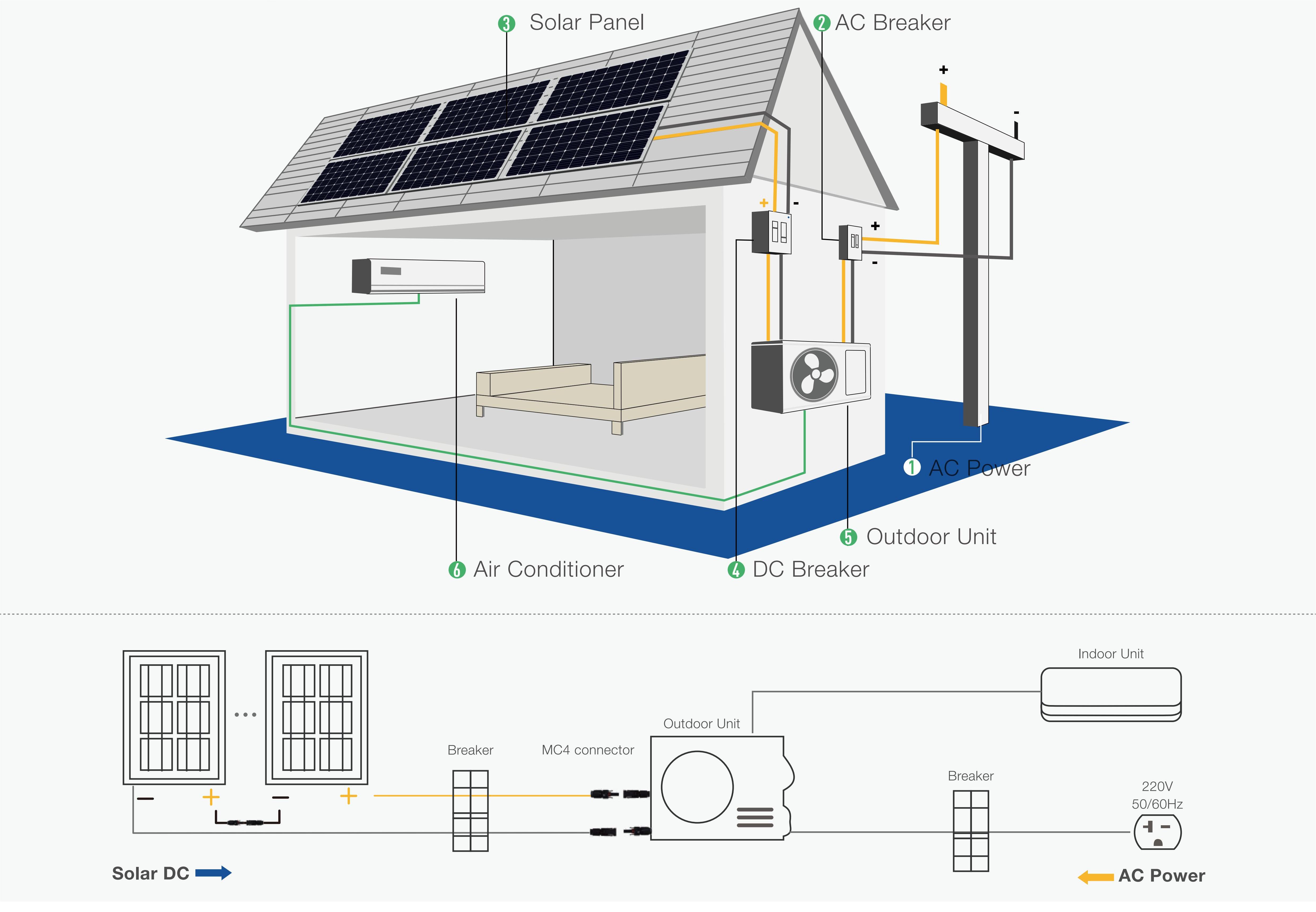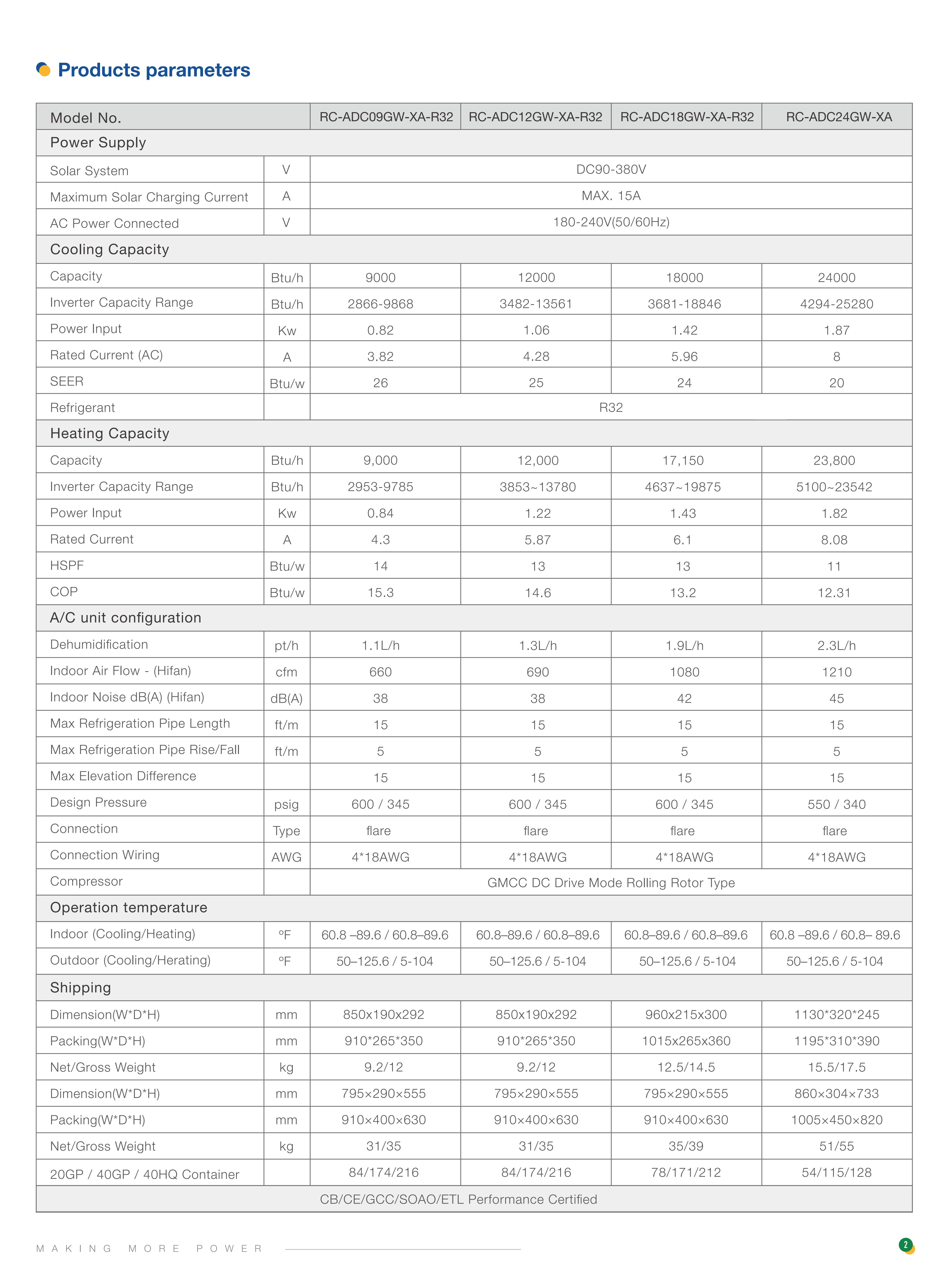A hybrid solar air conditioner combines traditional air conditioning technology with solar power to provide cooling while minimizing energy consumption and reducing reliance on the electrical grid. It utilizes both solar energy and electricity to operate, making it more energy-efficient and environmentally friendly compared to conventional air conditioners.
Solar panel voltage:
DC90-380VMaximum Solar Charging Current:
15AAC Power Connected:
180-240V(50/60Hz)Refrigerant:
R32Compressor:
GMCC DC Drive Mode Rolling Rotor TypeConnection:
Flare
Here's how a hybrid solar air conditioner typically works:
Solar Panels: The system usually includes solar panels installed on the roof or in a sunny location to capture solar energy.
Solar Power Conversion: The solar panels convert sunlight into electricity using photovoltaic cells.
Power Distribution: The generated solar electricity can be used directly to power the air conditioner or stored in batteries for later use.
Compressor and Condenser: The air conditioner's compressor and condenser components work similarly to a traditional air conditioner. They compress and cool the refrigerant, which circulates through the system.
Energy Source Selection: Depending on the availability of solar power, the air conditioner can switch between drawing power from solar panels or the electrical grid. If sufficient solar energy is available, it will prioritize using solar power.
Energy Efficiency: Hybrid solar air conditioners often incorporate advanced technologies to optimize energy efficiency, such as variable-speed compressors, smart thermostats, and efficient insulation.

Benefits of hybrid solar air conditioners include:
Reduced Energy Costs: By harnessing solar power, these air conditioners can significantly reduce electricity bills, especially during peak cooling demand.
Energy Independence: Generating power from the sun allows you to rely less on the electrical grid, promoting energy self-sufficiency.
Environmentally Friendly: Solar energy is a renewable resource that produces no greenhouse gas emissions, helping to reduce your carbon footprint.
Financial Incentives: In certain regions, there might be government incentives, tax credits, or rebates available for installing solar-powered systems, making them more financially attractive.
It's important to note that the efficiency and performance of a hybrid solar air conditioner can vary depending on factors such as the size of the system, local climate, solar panel capacity, and overall system design. Consulting with a qualified HVAC professional can help you determine the best solution for your specific needs.

A hybrid solar air conditioner combines conventional air conditioning technology with solar power to reduce energy consumption and environmental impact. While specific designs may vary, here are the general components you can find inside a typical hybrid solar air conditioner:
Photovoltaic (PV) Panels: These panels consist of multiple solar cells that convert sunlight into electricity. They are installed on the roof or any appropriate location to capture solar energy.
Solar Charge Controller: The solar charge controller regulates the flow of electricity from the PV panels to the air conditioner. It prevents overcharging of batteries and optimizes the charging process.
Batteries: In a hybrid solar air conditioner, batteries are used to store excess solar energy generated during the day for later use when sunlight is insufficient. The stored energy is utilized during the evening or when the demand exceeds solar generation.
Compressor: The compressor is a vital component of an air conditioner. It compresses the refrigerant, raising its pressure and temperature before it enters the condenser.
Condenser: The condenser is responsible for releasing the heat absorbed from indoor air to the exterior environment. It facilitates heat transfer from the refrigerant to the outside air, causing the refrigerant to condense back into a liquid state.
Evaporator: The evaporator is located inside the indoor unit and is responsible for absorbing heat from the indoor air. As the refrigerant evaporates, it absorbs heat and cools down the surrounding air.
Expansion Valve: The expansion valve regulates the flow of refrigerant into the evaporator. It reduces the pressure and temperature of the refrigerant, allowing it to absorb heat from the indoor air.
Air Handling Unit: This unit circulates the conditioned air throughout the building, distributing the cooled air to the desired spaces and returning warm air to the evaporator for cooling.
Control System: The control system manages the operation of the solar air conditioner, including temperature settings, fan speed control, and monitoring of system performance. It may include sensors, controllers, and user interfaces.
Electrical Components: Various electrical components, such as wiring, switches, relays, and circuit breakers, connect and control the different parts of the system, ensuring proper functioning and safety.
It is important to note that different manufacturers may have variations in the design and configuration of hybrid solar air conditioners, but the general principles and components mentioned above are typically present in such systems.
FAQs:
Q1: Do you support OEM/ODM?
A:Definitely, OEM&ODM service is supported with a certain quantity,including customize logo,package and label;
Q2: What's the production time?
A: The production time is normally 15 working days. but we will always prepare some stocks for popular models.
Q3: Can you provide DDP service?
A:Yes, if you are a personal customer and don't want to deal with the customs, we can provide DDP service to your address.
Q4: What about the warranty and how to claim?
A: Warranty period are 5 years since you receive the product, our professional after-sales team will deal with all warranty issues.